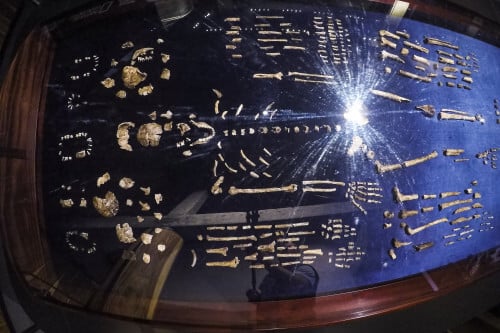New observations and excavations in South African caves have revealed that Homo naledi, an early human ancestor, deliberately buried their deceased and created crosshatch engravings on the nearby cave walls.
Fossils of Homo naledi were initially discovered in these caves a decade ago by a research team led by paleoanthropologist Lee Berger, currently a National Geographic Explorer in Residence. The team, including John Hawks and other researchers from the University of Wisconsin–Madison, recently published their new findings across three papers in the journal eLife, providing the earliest evidence of mortuary and symbolic behaviors in human ancestors.
Contrary to previous beliefs, which suggested that complex cultural behaviors such as burial and mark-making required a larger brain like those of Neanderthals and Homo sapiens, Homo naledi’s brain was only about one-third the size of modern humans. John Hawks, an anthropologist at the University of Wisconsin–Madison, emphasized that brain size alone doesn’t determine cognitive capacity, but rather how it is utilized and structured.
Moreover, Homo naledi exhibited a smaller physical stature compared to their human relatives. Analysis of the excavated skeletons suggests that the average Homo naledi individual weighed less than 90 pounds and stood less than 5 feet tall. Their smaller size facilitated easy navigation through the narrow and confined passageways of the Rising Star Cave System, where their remains were discovered. However, for human archaeologists and researchers, studying and excavating the cave site presents significant challenges.
The burials and crosshatch engravings were located in the Dinaledi subsystem of the cave, approximately 50 meters from the main entrance. Two burial sites were identified, one near the subsystem entrance and another further back in a separate chamber. The engravings appeared on both sides of a natural limestone column leading to the farthest burial site.
While natural limestone patterns erode and crack over time, John Hawks noted that the artificial engravings displayed distinct characteristics. They consisted of a few bold lines on a mostly flat surface, exhibiting multiple striations that indicate tool usage.
Among the engravings, one line in particular caught Hawks’ attention. It appeared near a spot in the limestone with a natural waved texture resulting from ancient algae fossils in the walls. The irregular lines in this section of the engravings seemed to have been repeatedly etched, as if the creator struggled to maintain a consistent mark due to the bumpy texture on the wall.
Furthermore, there were percussive marks on the panels, which Hawks suggested might have been made by Homo naledi repeatedly hitting a rock against the wall to produce sound.
Interestingly, the crosshatches engraved on the walls bore similarities to engravings made by Neanderthals found in caves at Gibraltar. This raises the question of whether these crosshatches held a shared meaning among different early hominid species.
Regarding the significance of these markings, Hawks mentioned that making simple patterns might be an easy and satisfying activity for the hominin nervous system. However, determining if these marks carried a deeper symbolic meaning remains elusive.
Complicating the interpretation of the engravings is their proximity to a significant location—a meter and a half away from the burial site of an extinct species.
To establish the intentional nature of the burials, the geology team, led by Tebogo Makhubela from the University of Johannesburg, compared the sediment layers beneath the Homo naledi remains with adjacent areas of the cave floor. The researchers discovered that the sediment layers beneath the fossilized remains exhibited signs of disturbance, unlike the uniformly distributed layers in the rest of the cave floor. This indicates that Homo naledi individuals were not simply laid down and left to rest, but rather, living individuals dug holes, placed the deceased in
them, and covered the remains with additional sediment.
One particularly intriguing burial site was situated at the base of the chamber entrance below a passageway known as “the chute.” Excavations in this area revealed extremely fragile bones. By carefully excavating around the bones and encasing them with plaster, the team successfully extracted an entire block of remains. Subsequent analysis using a CT scanner revealed the three-dimensional arrangement of a nearly complete skeleton, along with teeth and bones from at least three other individuals. To the team’s excitement, a rock artifact was found next to one of the individuals’ hands.
Describing the artifact as the “most interesting thing in the most interesting context,” Hawks speculated that it might be a tool used by Homo naledi to dig the burial holes. However, due to the lack of direct examination, it is currently impossible to definitively confirm whether the artifact is indeed a tool.
The next step for the team is to determine the most suitable approach to date the new evidence. They aim to establish the timing of each burial and whether the crosshatched engravings on the panels correspond to the same timeframe. However, before proceeding, they seek guidance and feedback from their peers on the best course of action.
Hawks believes that these new findings underscore the caves’ continued importance in unraveling the mysteries of human evolution. The team intends to involve more trained experts to thoroughly examine the caves for any overlooked evidence.
“We have to approach it like an escape room. We have to study every hidden detail now,” Hawks emphasizes. “This entire cave system might be part of some kind of cultural space.”
For years, researchers and graduate students from the University of Wisconsin–Madison have been studying and excavating Rising Star and other nearby sites in the Cradle of Humankind. Excavations in the nearby Dragon’s Back chamber, where anthropology graduate students Erica Noble and Sarah Johnson participated, are expected to yield further discoveries that shed light on human evolution.

